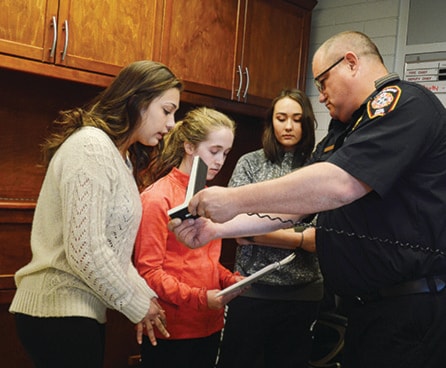“This is a test. Only a test. A test of the tsunami warning system...”
So goes the familiar, monotonous, refrain on the first Wednesday of every month at 1 p.m.
Or at least, so it’s gone until Anne Oswald’s Civic 11 class at ADSS decided to change it.
“It came from a place called Cannon Beach, that was the idea. They’re doing the same sort of thing [audible warning system] but with a cow mooing,” said Liam Clifford, 16. Cannon Beach, Oregon, has the sound of a cow mooing preceding their tsunami test.
“We looked through a billion sounds. We had some dubstep, didgeridoos, animal sounds,” Jen Banfield, 17, said.
The class narrowed down what could work and what wouldn’t.
“We realized that high pitched sounds aren’t going to work so we have to lower our tones,” said Freya Knapp, 16.
“We also had trademark issues: we couldn’t use Disney sounds,” said Clifford.
“We worked along Tim Pley, the fire chief. He’s the one that came to us with the idea,” said Frances Wilson, 17.
It’s not unusual for people in the community to pitch ideas to the Civics 11 class, Oswald said.
“Everyone knows we do stuff like this so different people approach us, send e-mails, see me in the streets and give us project ideas,” said Oswald.
In this case, people like Pley.
“The project’s been on our mind for a couple of years and the opportunity came up,” said Pley.
“My daughter Regan is in one of Ms. Oswald’s classes. I think my daughter actually said ‘my dad’s got a project for the Civics class.’”
“This sounded really interesting and it was something we’d never heard of,” said Wilson.
Pley and firefighter Brent Rose brought a portable tsunami broadcasting system to ADSS for the class to listen to different warning sounds and decide which they thought would be appropriate.
(story continues below)

The class then presented their plan to update the tsunami warning bulletin to city council at the April 27 public meeting.
On May 6, the Civics 11 class went to the Port Alberni Fire Hall—where the tsunami warnings are broadcast live—and several of the students had the opportunity to read out the monthly test message.
Rose and fire prevention officer Randy Thoen were on hand to assist the students and explain how the system worked.
Prior to purchasing the tsunami warning system in the early 1990s, the plan was to separate Port Alberni into different zones and when a tsunami warning needed to be issued, an emergency responder would drive around and blast instructions from a loudspeaker in their vehicle, Pley said.
The plan with the current four-speaker tsunami version is much the same.
However, 10 years ago when an actual tsunami warning was issued, Pley learned that it wasn’t working as intended.
“We learned that the system doesn’t have the clarity to reach out and give people specific direction and tell them that a wave’s going to be there by a certain time and they should go to this location,” Pley said.
“The best way to use it is to activate it in a pre-recorded siren based mode and so people will hear that and they’ll either know right away what it means or they’ll look for other information.”
Switching over to a siren-based system that is meant to alert rather than instruct means that people need their own emergency plan.
“People have to have their own personal evacuation plan,” said Pley.
And most people do—when firefighters went door to door a few years ago, 96 per cent of people in the tsunami zone knew they were, could hear the tsunami test and had an evacuation plan set up.
“That’s the new way of doing it. We’ll give you an alert when to activate your plan but your plan is your responsibility.”
To that end, the fire department would like to get to a pre-recorded push button message and get away from the verbal message.
The reason for the sound rather than a message is that the speaker system needs to be challenged, Pley said.
“The test doesn’t challenge the system the way we would like it to,” said Pley.
“The test should challenge the battery capacity and the ability to broadcast a sound like a siren for a prolonged period of time.”
But he doesn’t want a siren or anything that’s too high pitched.
“The advantage of having the didgeridoo is that it’s challenging, but very different than the siren that will play if there is an actual tsunami warning.”
Banfield agrees.
“You want something that associates with us but nothing that’s going to be misunderstood. You can’t use a train whistle, no bears. The cow they used in Cannon Beach if they did that here, I wouldn’t hear it. I have cows next door. I hear them all the time,” she said.
So she would likely tune out if she heard a cow mooing sound.
Some sounds the students considered were also a little scary.
“They played the sounds for us... some of them sounded demonic. Some of them are most definitely nos,” said Wilson.
“The elephant that we all thought would be cool at first and then we heard it and it was pretty bad on the system. Like scary.”
Changing the tsunami system will ultimately require council approval, said Pley.
He estimated it would cost about $3,000 (which might be available in the firefighting budget) to implement a new warning sound and make changes to the tsunami warning system.
The Civics 11 students plan to return to city council in the summer to present an update on their plan.
reporter@albernivalleynews.com
twitter.com/AlberniNews
